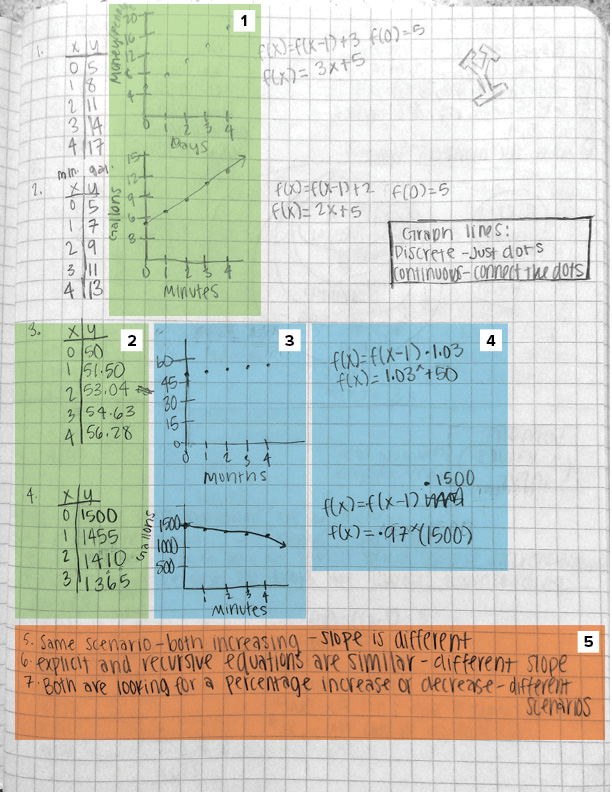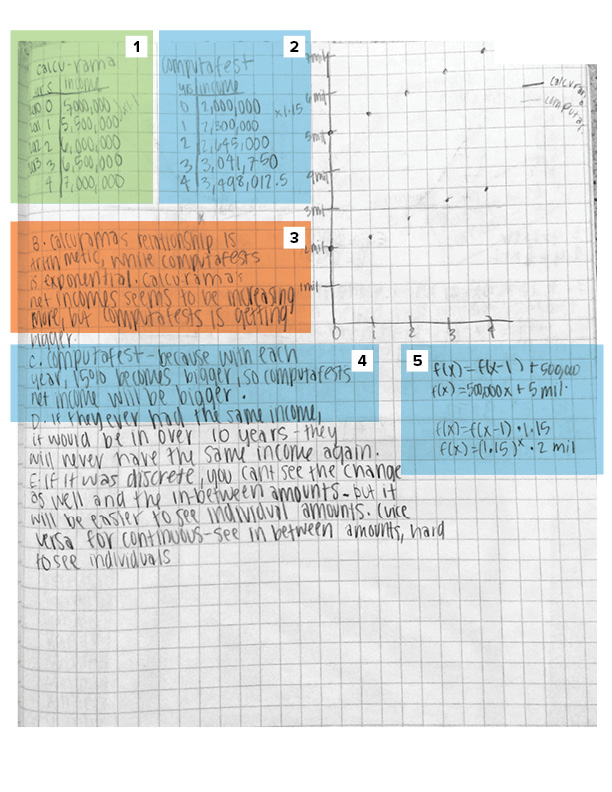All students should graduate from high school ready for college, careers, and citizenship.


1. Understanding
The student properly represents continuous and discrete settings in each graph.
2. Understanding
Why does the student seem to struggle with the representations for what is happening in questions 3 and 4? The defining features and parameters in the equations, tables, and graphs do not all align with each other in the exponential situations in the same way that they do align in the linear situations.
3. CCSS Alignment
The student distinguishes between linear and exponential equations in questions 1 – 3, but initially shows situation 4 as decreasing at a constant rate, but then revises the student’s thinking. Even though the chosen scale on the graphs of the exponential functions tends to make the graphs appear linear, the student still correctly identifies linear and exponential situations.
Standard referenced:
HSF-LE.A.1: Distinguish between situations that can be modeled with linear functions and with exponential functions.
4. CCSS Alignment
The student correctly constructs linear equations in both recursive and explicit form. However, there are some issues with the exponential functions. The explicit equation on question 3 has issues with how to use the starting amount in the equation and the recursive on question 4 has issues with which number to treat as the growth factor.
Standard referenced:
HSF-LE.A.2: Construct linear and exponential functions, including arithmetic and geometric sequences, given a graph, a description of a relationship, or two input-output pairs (include reading these from a table).
5. Comprehension & Application
SMP.7: Look for and make use of structure.
The student understands very well the structure of representations that are linear. There is still some work that needs to be done on looking at the structure of exponential models.

1. Understanding
What is the student looking at when the student multiplies by 1.1? Is this an attempt to see if the table could be described with a common factor?
2. CCSS Alignment
The student correctly identifies parameters for both linear and exponential functions, is capable of using large numbers, and is handling the percent growth correctly in both equations and tables.
Standard referenced:
HSF-LE.B.5: Interpret the parameters in a linear or exponential function in terms of a context.
3. Comprehension & Application
SMP.7: Look for and make use of structure.
The student understands the structure of the two function types. The student makes a claim about the functions that is not supported by the tables or graph, but seems likely to have come from understanding the structure of the types of functions.
4. CCSS Alignment
The student recognizes that the exponential equation will overtake the linear one. The student states that initially, the linear increases faster, eventually the exponential increases faster.
Standard referenced:
HSF-LE.A.3: Observe using graphs and tables that a quantity increasing exponentially eventually exceeds a quantity increasing linearly, quadratically, or (more generally) as a polynomial function.
5. CCSS Alignment
The student can create linear and exponential functions correctly.
Standard referenced:
HSF-LE.A.2: Construct linear and exponential functions, including arithmetic and geometric sequences, given a graph, a description of a relationship, or two input-output pairs (include reading these from a table).
